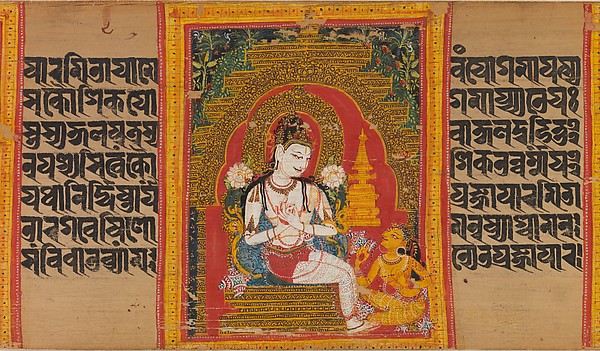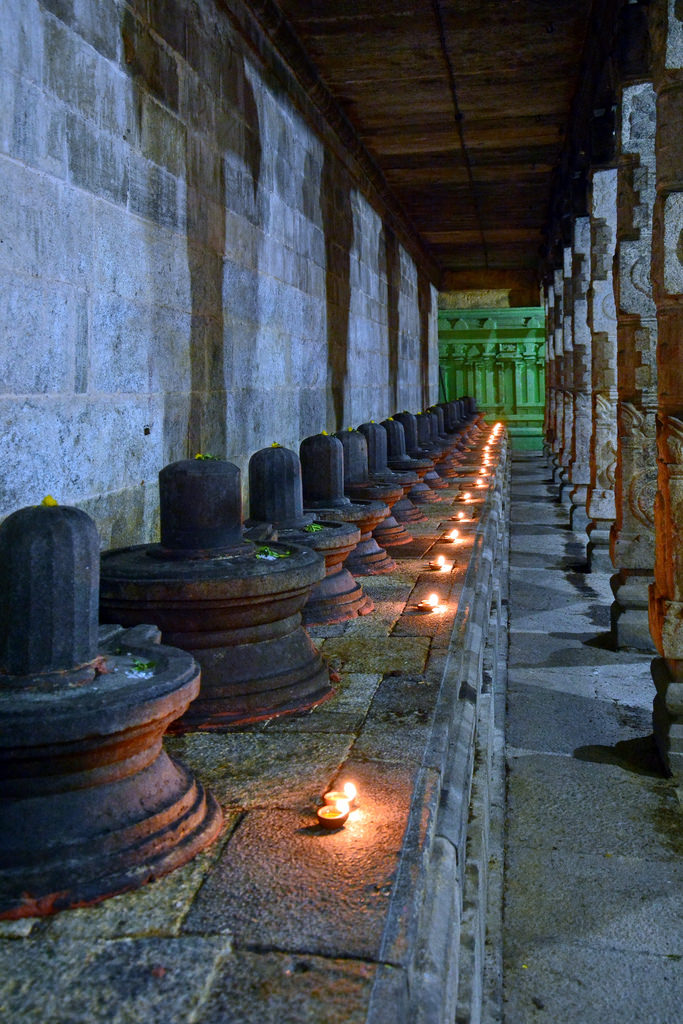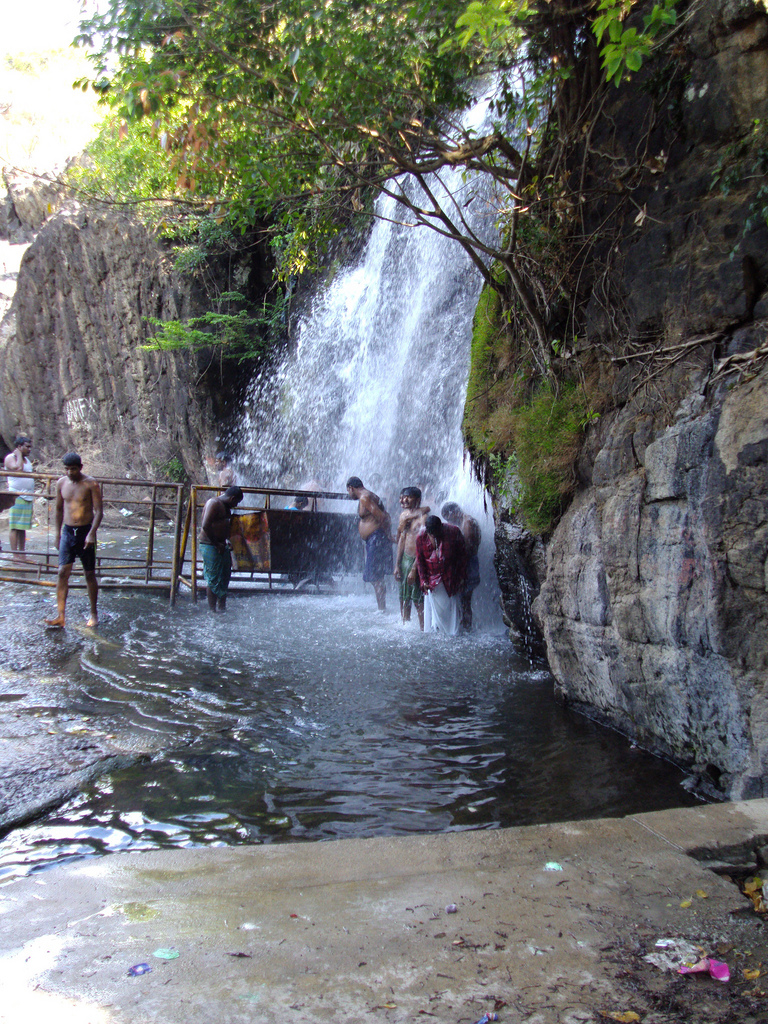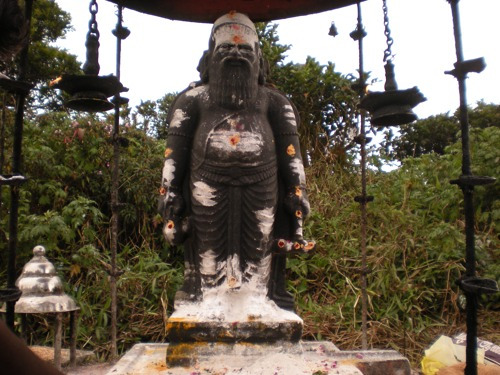The Potalaka of India: a Pilgrim’s Introduction.
om namah shrilokeshvaya
Potalaka, the abode of Arya Avalokiteshvara, is described in several sutras and tantras as a beautiful forested mountain. Remarkably, there exists a text by Arya Avalokiteshvara himself, preserved in Tibetan translation, that describes how to perform a proper pilgrimage to the Potalaka mountain, in South India. Readers may wish to consult that text to know the proper mantra accumulations and practices to be done. Here I will offer a few practical suggestions on how to reach the Southern Potalaka.
 This has been identified, although not all agree, with the Pothigai Malai or Potityil, in Tirunelveli district of Tamil Nadu. The easiest way to visit the area, is to take a train to Tirunelveli from Chennai; there you will need to obtain a special permit from the National Parks Office, since in fact the Pothigai is within the Mundanthurai Tiger Reserve, India’s Southern-most Tiger Reserve, at least, if you wish to stay there at night.
This has been identified, although not all agree, with the Pothigai Malai or Potityil, in Tirunelveli district of Tamil Nadu. The easiest way to visit the area, is to take a train to Tirunelveli from Chennai; there you will need to obtain a special permit from the National Parks Office, since in fact the Pothigai is within the Mundanthurai Tiger Reserve, India’s Southern-most Tiger Reserve, at least, if you wish to stay there at night.

While going there, it may be worth visiting some of the sites in Tamil Nadu with the most obvious Buddhist connections. Kanchipuram used to be a great center of Buddhism; in Ekambaranathar temple you will still find several Buddha images. Remarkably, this temple has a very high number of lingas, and Arya Avalokiteshvara’s pilgrimage guide mentions that you will find a temple with a high number of Avalokiteshvara-lingas. Kachapeshvara temple also has several Buddha images on its pillars. Ekambareshvara is an excellent temple for those who like to spend some time in quiet practice.
Like Kanchi, Rameshvaram is a Buddhist Tantric pīṭha, especially connected to the Yoginitantras. The place is particularly important for Rama, who according to the Buddhist tradition, is one of the previous life of the Buddha. Rameshvaram also has beautiful seaside, where you may enjoy the sight of coral.
Near Kanyakumari, the place where three seas meet and the Southern-most tip of India, there exists a small temple, where you may find statues of Arya Avalokiteshvara and Tara. Many years ago, I taught the respective mantras to the local priest, who said he will chant them at least once a month. The temple was somewhat neglected and at the time had very few visitors. A perfect place to do practices connected to Arya Avalokiteshvara and Tara.

From Tirunelveli, after obtaining the required permissions, you may reach Mundanthurai Tiger Reserve by bus. It’s possible to have accommodation inside the Reserve once you have obtained the proper authorization, but it used to be possible to stay at the village a few kilometers before even without it, and visit the reserve by day. The village has a Agastya Temple by the river; this great sage is also said to have been one of the Buddha’s previous lives. Inside the reserve too, there is a Papanasha, Destroying Sins waterfall, connected to sage Agastya, which can be reached by boat, it is on the other side of a large dam. To visit the interior of the reserve, and thus see the peaks of Pothigai, you must be accompanied by a guide. There are boars, monkey, leopards, large snakes and of course tigers. There are also rivers and waterfalls, and a hidden village of adivasi, the oldest inhabitants of India.
Back to Tirunelveli, it’s worth visiting the Shiva temple in town. The Small Letter on Going to Potalaka says that those who will not succeed in seeing Arya Avalokiteshvara as Mahakala on the peaks themselves, will be able to see him as Shiva in the plains. Thus you should not miss Nellaiappar Temple.
I will now retell the same thing in Sanskrit verses.
|| potalakayātrāsmr̥tiḥ ||
Recollecting the Pilgrimage to Potalaka
|| oṁ namo gurave ||
oṁ, I bow to the Guru!
śrīmatpotalake ramye pakṣikūjitabhūṣite |
dr̥śyate jñānapuṇyābhyāṁ lokanātho namāmi tam ||1||
In the splendid Potalaka mountain, adorned by the warbling of birds,
Lokanātha is seen thanks to awareness and merit: I bow to him.
asti yā bhārate deśe dakṣiṇā dik suvistr̥tā |
tatrāsīd dharmabāhulyaṁ bauddhadharmo viśeṣataḥ ||2||
In the country of Bhārata there is a very extensive Southern area;
there, many types of Dharma used to exist; and especially, the Buddhist Dharma.
āryanāgārjunādīnāṁ janmabhūmiḥ prakīrtitā |
anekasūtratantrāṇāṁ ākaraḥ paramādbhutam ||3||
It is extolled as the birth place of Ārya Nāgārjuna and others;
It is the source of many Sūtras and Tantras, a supreme marvel.
kāñcīnāmni mahāpīṭhe santy adyāpi tathāgatāḥ |
āryalokeśaliṅgāni sahasraṁ cāpi mandire ||4||
In the great sacred place of Kāñcī, even today there are Tathāgatas;
and in a temple we find the one thousand Liṅgas of Āryalokeśa.
tataś ca dakṣiṇe deśe mahāpīṭhe rameśvare |
bhagavān pūrvavāse ’sau śrīrāmaḥ saṁprapūjyate ||5||
And South of that, in the great sacred place of Rameśvara,
the Bhagavat in a previous life, splendid Rāma, is worshipped.
tataś ca dakṣiṇe deśe sāgaratrayasaṁgame |
āryatārā ca lokeśo nirmāṇākārasaṁsthitau ||6||
And South of that, in the place where the three seas meet,
Noble Tārā and Lokeśa remain in Nirmāṇa form.
tataś ca nātidūrasthaḥ parvataḥ paramaḥ śubhaḥ |
śrīmatpotalako nāma nāthasyaikasya ketanam ||7||
And not far from that is the supremely beautiful mountain,
called Potalaka, the abode of the sole Protector.
jharaiś ca śabdite kūṭe saraho vyāghrarūpabhāk |
gato dikkālaśūnyatvaṁ yāty adyāpi sa līlayā ||8||
And in the peak that resounds with waterfalls, Saraha, in the shape of a tiger,
set in the emptiness of directions and time, even now moves about in elegant play.
bodhisattvo yadā cāsīd agastyo yogināṁ varaḥ |
bhagavān vasatiṁ cakre harite puṇyaparvate ||9||
 And when he was a Bodhisattva, as Agastya, best among yogins,
And when he was a Bodhisattva, as Agastya, best among yogins,
the Bhagavat dwelt there itself, in the green mountain of merit.
mahākālasya rūpeṇa dr̥śyate śikhare ’thavā |
lokeśaḥ śivarūpeṇa dr̥śyate nagare ’pi saḥ ||10||
Lokeśa can be either seen at the top of the mountain in the form of Mahākāla;
or, he can also be seen in town, in the form of Śiva.
puṇyaprajñāprabhedo ’yaṁ lokeśena prakāśitaḥ |
śrīpotalakayātrākhyapattrikāyāṁ svayaṁkr̥tau || 11||
Lokeśa explained this as being due to a difference in merit and wisdom,
in the letter called “Pilgrimage to Splendid Potalaka”, which is his own composition.
draṣṭavyā pattrikā saiva yātrāmantrajapāśayaiḥ |
mayātra kevalaṁ sāro likhitaḥ svasmr̥teḥ kr̥te ||12 ||
Those who wish to recite the mantras for the pilgrimage should see that very Letter;
here I have only written about the essence, for the sake of my own recollection.
nirālambakr̥pākūṭa āśrayo yasya nāśrayaḥ |
taṁ lokeśam anusmr̥tya yat puṇyaṁ syād dhitaṁ tataḥ ||13||
On the peak of compassion without point of reference, he abides without abiding;
having brought to mind Lokeśa, whichever merit has resulted, may it bring benefit.
iti potalakayātrāsmr̥tiḥ | kr̥tir iyaṁ dharmavardhanajñānagarbhasya || śubham ||
This was the Recollection of the Pilgrimage to Potalaka, composed by Dharmavardhana Jñānagarbha.
May there be goodness!
I am extremely grateful to Harunaga Isaacson for very useful suggestions and corrections; and to Erik Pema Kunsang for prompting this composition and post.
Photos provided by the author.
